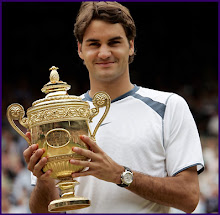Problem
Solution
Problem
Solution
"Sensible technique and thoughtful strategy will turn you into a force at net." | ||
Whenever you stop playing for a while, or whenever your game goes into a slump, one of the first things to go is your timing. Strokes that felt natural and automatic start to feel like they've been replaced with awkward and forced imitations. And usually, the harder you try to fix the problem, the worse it becomes. But there's an easy solution that you can use any time you need to bring your timing and your strokes back into focus. It's called the “bounce-hit” drill.
Introduced by Timothy Gallwey in his classic book The Inner Game of Tennis, bounce-hit is deceptively simple, but it works like magic.
Here's how to do it:
Whenever the ball bounces, say "bounce" aloud to yourself. And whenever you or your opponent hits the ball, say "hit" aloud as well. This exercise works because it engages your mind enough to allow the more automatic, semi-conscious part of your brain to take over. That helps return your timing and your strokes to normal. And as a bonus, this drill works just as well when you're nervous or when you feel you're thinking too much on the court.
PROBLEM
(see pic above)
SOLUTION
(see pic below)
When you’re in the set position before you serve, start with your weight on your back foot. As your tossing arm goes up, shift your weight forward onto your front leg. This will help you get your toss in front of your body. It will also get you leaning into the serve and your body moving into the court as you swing through the ball. With the ball in front of you, rather than behind your head, you can hit a stronger flat or slice serve. Initially you may feel like you’re falling forward, but with some practice this momentum will add even more power to your serve.
One of the rules of the playground is that you should always stand up to a bully. Show weakness and you’re just asking to be pushed around. You can’t allow yourself to be intimidated on the tennis court, either. If your opponent smells fear coming from your side of the court, his confidence and play will usually soar. One of the more common tormentors in tennis circles is the big-serving bully. This is a player who relies on a powerful first serve to win a lot of free points, which lets him take more chances on his other shots. If you have trouble returning his serve, it’s a style that can put a lot of pressure on you. But if you neutralize his weapon, he’s nothing to be scared of.
Here’s how:
Stand a few steps back: Many power servers favor pace over placement. They simply try to overwhelm you with the speed of the serve because they don’t possess the precision to aim for the lines. So give yourself a little extra time to return it by starting farther back in the court (try a couple of feet behind the baseline) than you usually stand. Unless your opponent is following the serve to net, there’s really no benefit in contacting the ball any earlier. You’re better off forcing him to volley rather than piling up errors.
Shorten your take back: You don’t have a lot of time to set up for the return of a big serve. Luckily, since your opponent is giving you so much pace, you don’t need to take a big swing. Simply making solid contact out in front of your body is all that’s necessary for an effective return. Your backswing should essentially be limited to your shoulder turn.
Hit from an open stance: Again, you’re being rushed, so footwork is at a premium. Rather than taking several steps to position yourself, the most efficient way to make the return is to the line up the incoming ball with your outside, or back, leg and lean into the shot. The coil of your upper body and the pace of the serve will supply the power. This will not only help you put more serves in play, it will allow you to move more effectively for the next shot.
